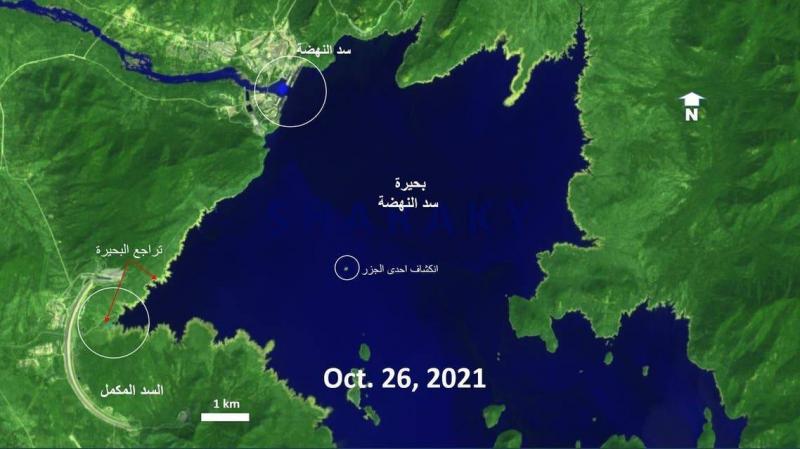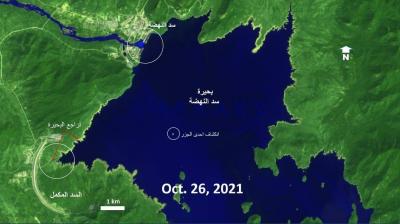Three weeks ago, a source from the Sudanese Foreign Ministry announced that Ethiopia had begun raising the middle corridor of the Renaissance Dam and constructing concrete walls in preparation for the third filling of the dam. Amid increasing speculation about this, Egypt and Sudan continue to insist on the need for negotiations to reach a binding and legal agreement regarding the filling and operation that guarantees the rights of both countries. Egyptian President Abdel Fattah al-Sisi emphasized during his meeting yesterday evening with Austrian Chancellor Alexander Schallenberg on the sidelines of the United Nations Climate Change Summit in Britain the high priority Egypt places on its historical rights to the Nile River's water, viewing it as an existential issue that requires the international community to exert all possible efforts to reach a binding legal agreement regarding the rules for filling and operating the dam. But has Ethiopia really prepared for the third filling?
Dr. Abbas Sharaki, an Egyptian water expert, confirmed that filling the dam's reservoir begins during the rainy season, which lasts from June to September each year, and the storage level is tied to the elevation of the dam's middle corridor. Therefore, no construction can commence in that corridor during rainfall or increased likelihood of rain. According to the expert’s insights shared with “Al Arabiya.net,” any construction on the Renaissance Dam could start from November onwards, by discharging part of the water to dry the middle corridor, adding that concrete works to raise the corridor could begin next February to reach an elevation of 20 meters, achieving a water level of 595 meters, to allow for the storage of 10.5 billion cubic meters, bringing the total storage next summer to 18.5 billion cubic meters.
Regarding the dam's storage levels, the Egyptian expert revealed that satellite images from the dam site confirm a continued decline in storage, indicating that the two lower discharge gates have remained closed since mid-August. He explained that some small islands that were submerged in water are now becoming exposed with the increased decline of the reservoir’s level.
For his part, Dr. Mohamed Nasr Allam, former Egyptian Minister of Irrigation, stated that conducting construction works in the middle corridor of the Renaissance Dam is currently difficult due to ongoing rain conditions; however, Ethiopia might be able to carry out some construction work around the dam's site but away from the middle corridor. He confirmed to “Al Arabiya.net” that raising the dam and the third filling renders negotiations futile, as the higher the dam rises, the greater its risks, especially with scientific studies affirming its instability and the presence of subsidence at its site that threatens its potential collapse.
He stated that there is an urgent and necessary need to change the negotiation mechanism to avoid the tremendous risks posed by Ethiopia's attempts to reduce the flow of the Blue Nile, consequently impacting Egypt's water share. He called for initiating trilateral negotiations within an agreed timeframe of three months to reach a binding legal agreement on the rules for filling and operating the dam, while preserving Egypt's historical rights.
The Ethiopian Foreign Ministry had announced last July that the second filling of the Renaissance Dam had occurred as planned at the amount of 13.5 billion cubic meters, adding that this filling did not harm Egypt or Sudan. Despite Ethiopia having previously sent formal communication to the ministries of irrigation in Egypt and Sudan regarding its decision to commence the second filling in two phases at the specified amount, Egyptian experts had previously confirmed to “Al Arabiya.net” that these claims were incorrect and that Addis Ababa did not store more than 4 billion cubic meters during the second filling, which lasted for only two weeks.
In September, the UN Security Council urged Egypt, Ethiopia, and Sudan to resume African Union-led talks to reach a binding agreement "within a reasonable timeframe" regarding the operation of the Renaissance Dam. The Council's official statement called for the three countries to progress in the negotiations led by the African Union constructively based on cooperation and to swiftly conclude an acceptable and binding agreement among the parties regarding the filling and operation of the dam within a reasonable timeframe. Both Egypt and Sudan had sought the Council's assistance in resolving the dispute after Ethiopia began filling the reservoir for the second consecutive year in July.




